What is a soft starter and how does it work?
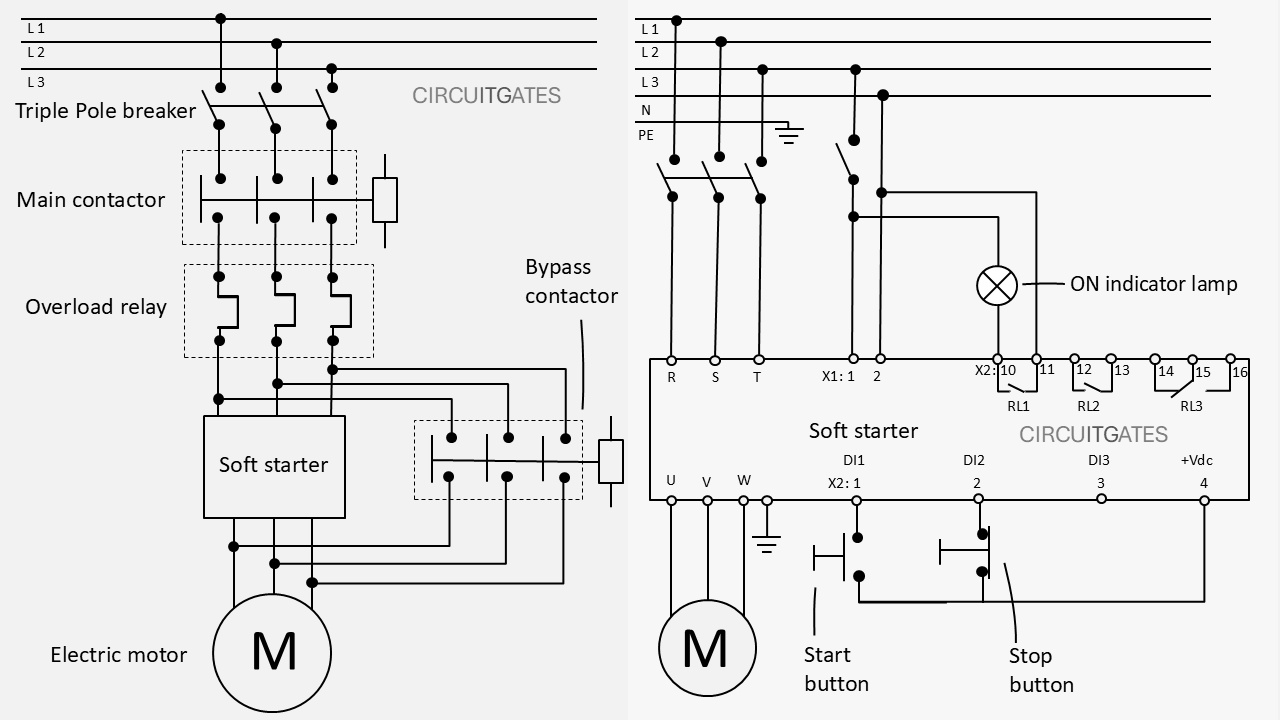
A soft starter is a device used to control electric motors; that is to start, run, stop and more importantly it is designed to smoothly start and stop electric motors.
Electric motors draw a lot of current during starting (inrush current) due to low impedance (resistance and inductance) of its windings during starting and this has a significant impact to larger electric motors.
High inrush current causes an electric motor to start with unnecessary high speeds that result in vibrating of equipment and the motor itself, giving them mechanical stress and eventually failure.
While cheaper starters like star-delta starters, can reduce starting current, they are not much effective as soft starters in situations where smooth starting is a needed, like in moving a conveyor belt having fragile materials.
A soft starter smoothly starts electric motors by initially applying a reduced voltage to the electric motor and gradually increases the voltage to full voltage.
If voltage is reduced, current is also reduced and the force applied by the motor (torque) will be also low, thereby smoothly starting electric motors
During stopping, a soft starter gradually decreases the voltage being applied to the motor to zero and the electric motor smoothly stops.
Soft starter construction and working
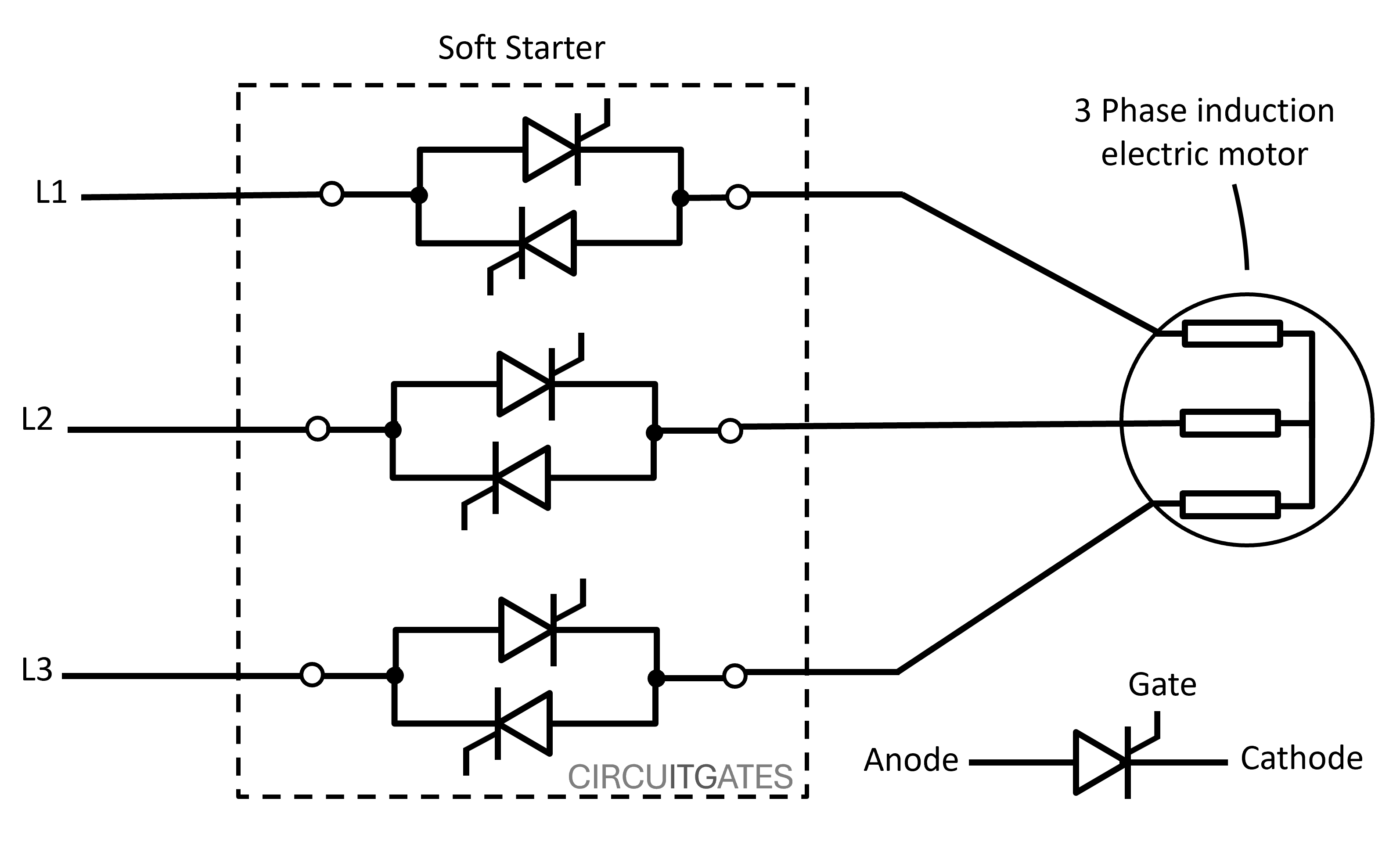
As shown in the previous diagram, a soft starter mainly consists of a pair of anti-parallel thyristors (silicon-controlled rectifiers SCRs) on each of the three phases.
An SCR or thyristor is a three terminal semiconductor device that allows current through it in only one direction just as a rectifier diode, which is why they are connected facing different directions on each phase or in anti-parallel way, so that AC can flow in the forward and reverse direction.
The device (thyristor) exists only in two states, the ON state and the OFF state. In soft starters, they work as a controlled switches to control the AC electric motors.
An SCR is different from a rectifier diode in that, for an SCR to allow current through it (or from anode to cathode) there must be a sufficient voltage usually of small value between the gate and cathode to put the SCR in ON state.
Ones an SCR goes in the ON state, the only way to put it in OFF state is to reduce the supply voltage to zero (the voltage between the anode and the cathode).
Since the supply in soft starters is AC, that has voltage and current that grow from zero to maximum several times in every second, the SCRs are put in ON and OFF state several times per second
For a soft starter to smoothly start the electric motor, the SCRs are first put in on state at nearly the end of every AC half cycle and this results in small amount of voltage applied to the electric motor as shown in the following diagram.
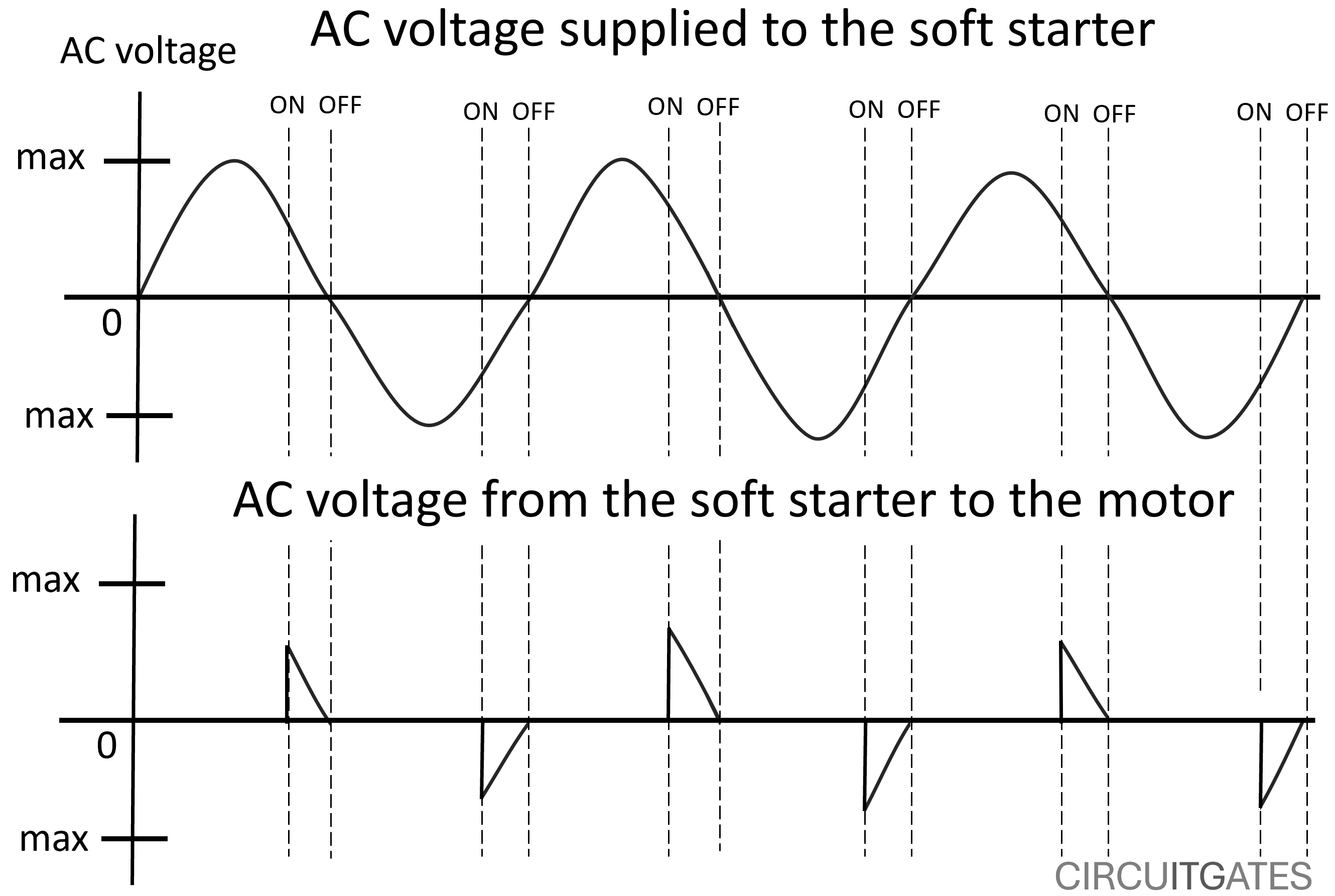
To gradually increase the voltage to the electric motor, the SCRs are put in ON state much earlier and earlier of the AC half cycles and this results in increase in voltage to the motor, until the electric motor receives full voltage.
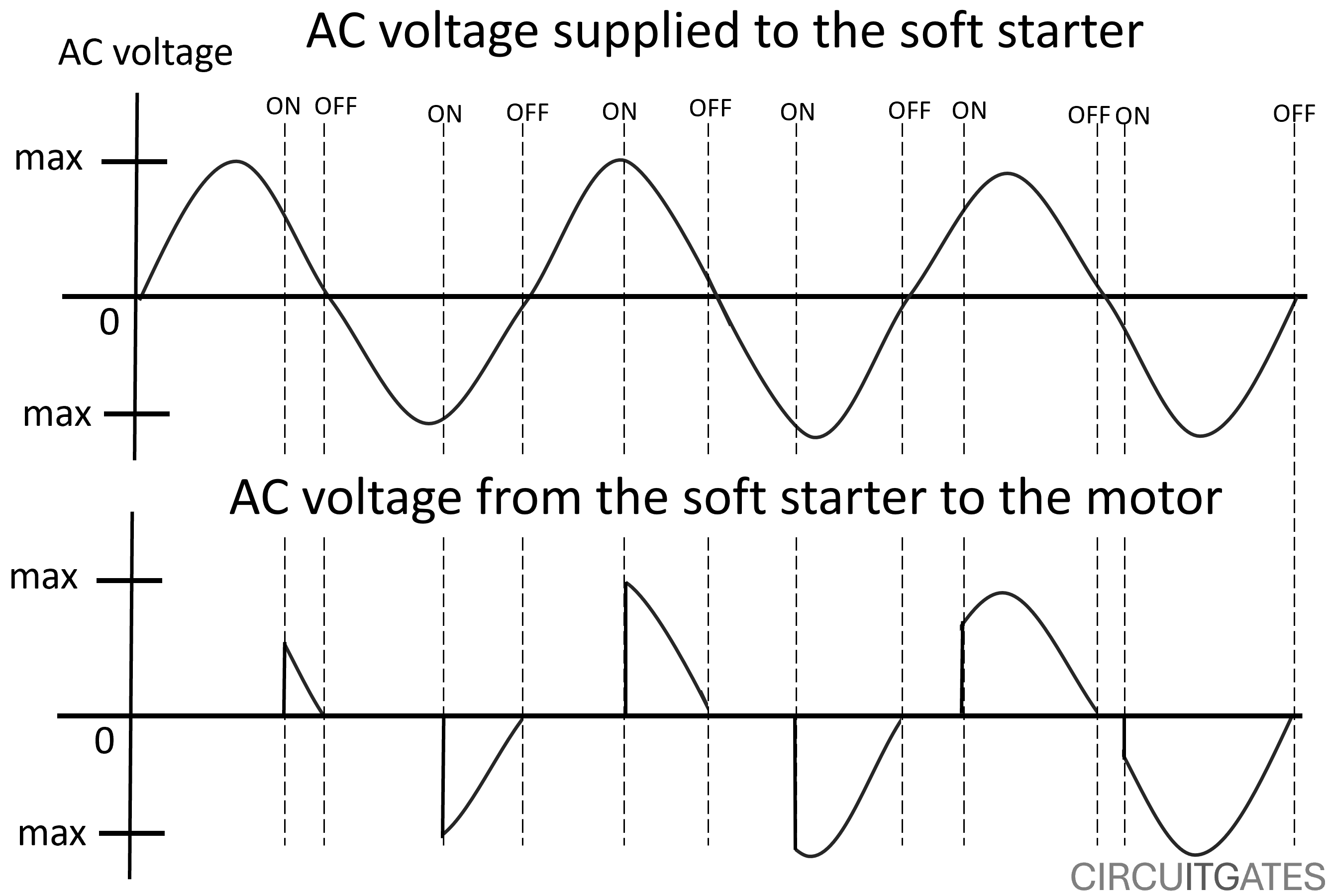
The gate - cathode control paths of the SCRs are connected to the printed circuit board assembly that controls the ON and OFF of thyristors based on the parameters set by the operator such as acceleration time.
Connecting soft starters
There are several ways in which soft starters are connected, sometimes they feature a main contactor, separate overload relay, bypass contactor and other components.
While the soft starter can work properly by just connecting it to the electric motor through the three-phase circuit breaker, as shown in the last diagram, other devices can be added to achieve certain controls which we are now looking at.
Soft starters can be installed with a main contactor, a bypass contactor, an overload relay and others as shown in the following diagram.
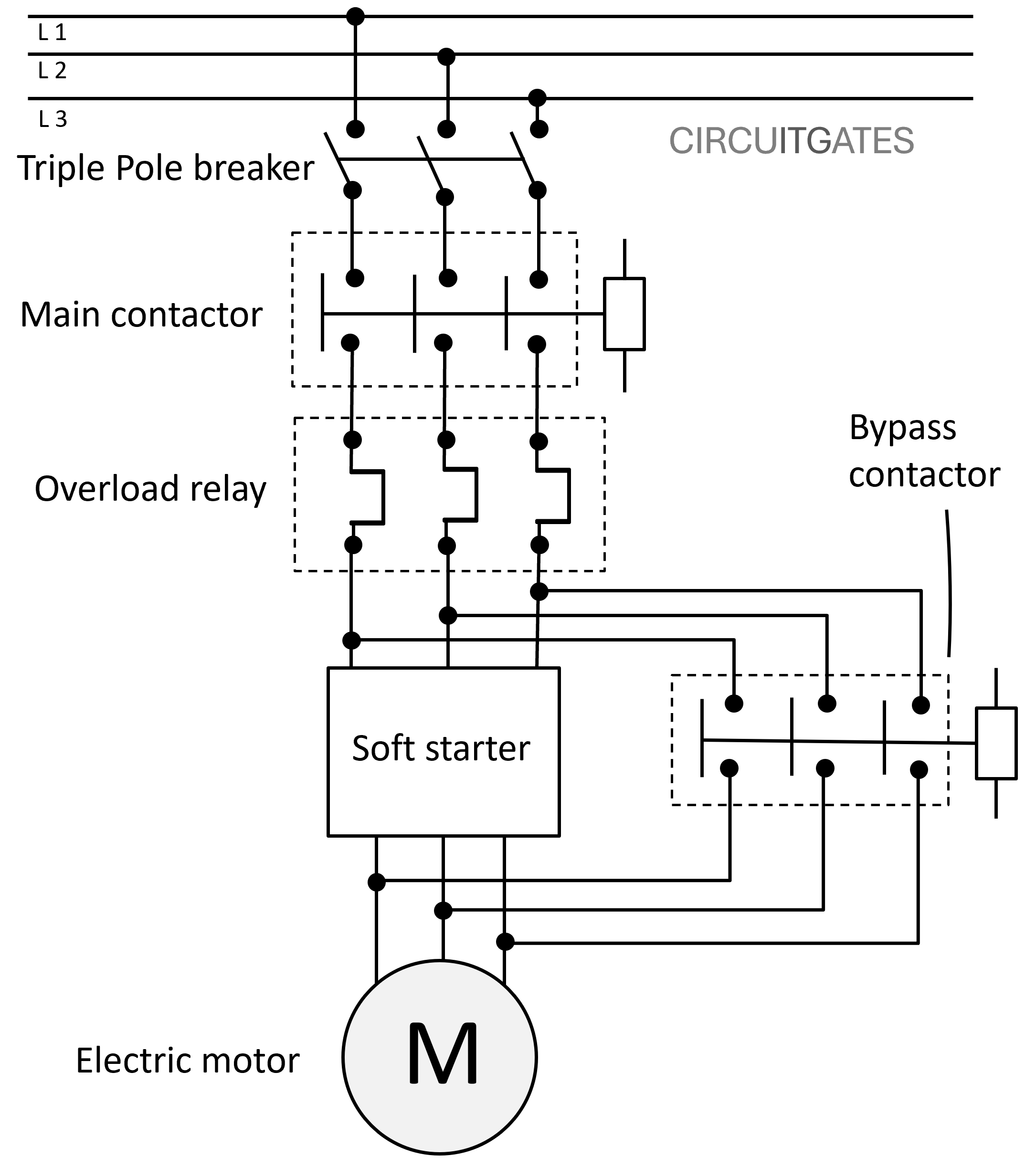
In soft starters, main contactor provides a physical isolation when the starter is not in use and in the event of a soft starter trip.
Electronic components inside a soft starter such as SCRs do not offer a high degree of isolation because they have a problem of current leakage through them. When the main contactor is used, the electric motor will not automatically starts in the event of stoppage.
A soft starter installed with a bypass contactor is to reduce the dissipation of heat by thyristors. Electronic components inside a soft starter dissipate heat during running that lead to soft starter overheating and failure.
To overcome overheating of soft starters, soft starters are often installed with bypass contactors. Some soft starters have inbuilt bypass contactors. Soft starters with inbuilt bypass contactors don't need an external bypass contactor.
Bypass contactor provides an alternative way to the soft starter for current and voltage to reach the electric motor when the motor reach full speed or full voltage.
On separate overload relay; if the soft starter is designed in a way such that when bypassed through a bypass contactor, its internal overload relay will not be able to do its work, then an external overload relay must be installed.
Controlling the soft starter
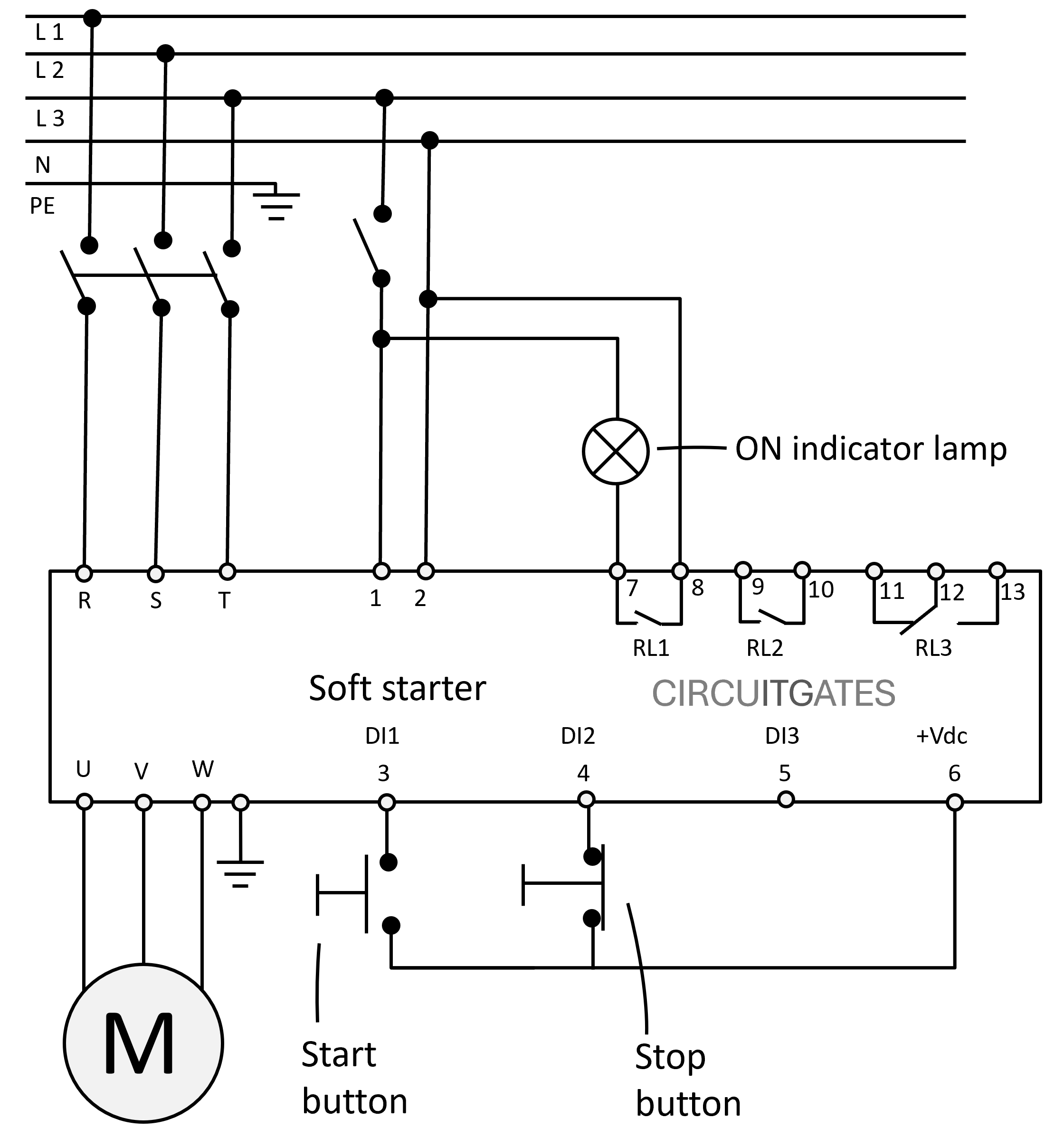
The control circuit of most soft starters consist of control supply, digital inputs, digital outputs (output relays), and serial communication protocols that enable sending and receiving of different types of signals that anable the control of soft starters.
For inputs, outputs and serial communication protocols to control the soft starter, there are soft starter parameters that need to be set or programmed first that correspond to these inputs, outputs and serial communication protocols.
The control supply
The control supply part of the soft starter is used to supply voltage to the circuit board, fans and more in the soft starter.
The control suppply voltage terminals are usually marked 1 and 2 or A1 and A2. A common voltage for control supply voltage is 100V to 250V AC. In the previous diagram we have used a supply of 230V.
Digital inputs - DI1, DI2, DI3
These are inputs that receive individual (discrete) signals that are either on or off (binary 0 or 1), from devices such as start and stop buttons
When parameters corresponding to these digital inputs are set, they can be used to control various functions of the soft starter such as switching ON and OFF the soft starter, as in the previous diagram.
Digital outputs (Output relays - RL1, RL2 )
These are outputs that sent individual (discrete) signals that are either on or off (binary 0 or 1) to external devices like indicator lamps and solenoid valves.
In soft starters we often find output relays used as digital outputs. Soft starter output relays can be programmed to close if the soft starter is switched ON, enabling an external circuit connected through it to operate.
For example, on other soft starters, the RL1 can be programmed to activate an external bypass contactor when the motor starts to receive full voltage.
Serial communication protocols
Serial communication protocols involves the use of PLCs and remote HMIs (touch screens or screens with a keypad usually installed on the panel door containing the soft starter) to control the soft starter.
Some common types of serial communication protocols include fieldbus, ethernet and wireless.
Soft starter Programming
Programming involves the setting of soft starter parameters for the soft starter to suite specific electric motor applications.
To set parameters for the soft starter, you need to have its user manual since different brands of soft syarters slightly differ on how they are programmed.
There are several parameters that need to be set so that the soft starter match the specific electric motor applications, and also to anable the operation of the soft starter through digital inputs, analogue inputs, serial communication protocols and more.
Some of the areas where parameters need to be set include:
Starting and stoping of the Electric motor
In soft starters, the electric motor can be started using the soft starter keypad (local HMI), PLC (through serial communication protocol) and external start and stop buttons (through digital inputs).
The soft starter needs to be programmed based on which of the previous methods of starting the electric motor is going to be used in the starting and stoping of the motor.
In the previous soft starter power and control circuits diagram, we have used the external start and stop buttons connected through digital inputs DI1 and DI1 from the internal 24Vdc supply terminal.
Some Soft starters have no internal 24Vdc supply and in that case an external 24Vdc supply is needed.
On WEG soft starters, to use external start and stop buttons wired through digital inputs DI1 and DI2 to start and stop the electric motor (three wire control), we need first to go to parameter 61 (P61) and set the parameter 61 to OFF (P61 = OFF)
When the P61 parameter programmed to ON (P61 = ON), the motor will start and stop via the soft starter keypad and serial communication protocol only.
And then go to parameter (P53) and set it to OFF, to allow ON and OFF from two digital inputs (DI1 as start input and DI2 as stop input). Without setting this parameter, the ON and OFF will be only from DI1 (two wire control).
Other important Soft starter parameters
Starting voltage - Usually found on P1, for setting the starting voltage that will be applied to the electric motor
Acceleration time - Usually found on P02, which allows to set the time of the voltage increment to full voltage
Soft starter current limitation - allows to set the maximum current value that can be supplied to the electric motor.
If you have made it this far, thanks for reading. Please consider subscribing to our YouTube channel for more electrical tutorials.